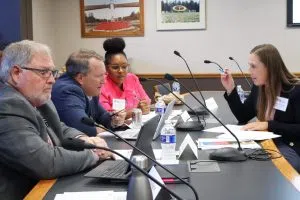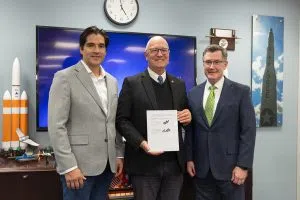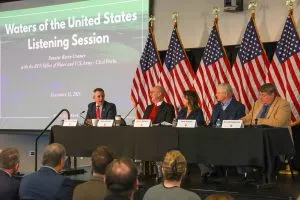
From the left, Rep. Pat Heinert, R-Bismarck, Shane Goettle, Joy-Nicole Smith, school liaison program manager for Minot Air Force Base, and Sen. Michelle Axtman, R-Bismarck, participate in a meeting of the North Dakota Educational Opportunities Task Force on Thursday, Sept. 26, 2024. (Michael Achterling/North Dakota Monitor)
(North Dakota Monitor) -No draft legislation emerged from a school choice task force but the lawmaker leading the group is working on a plan that would provide additional funding for all North Dakota K-12 students.
The Educational Opportunities Task Force, focused on school choice education models, met over the summer and held its final meeting at the Capitol on Thursday. It was born out of the interim Education Committee’s assignment to study school choice models, though some members of the committee initially questioned the transparency of the process.
In an interview with the North Dakota Monitor after the last meeting, Sen. Michelle Axtman, R-Bismarck, chair of the Education Committee and member of the task force, outlined a different framework for a tiered student assistance program for North Dakota that would augment public education funding to give students more options and resources. She added North Dakota would be the first state in the nation to implement a tiered school choice program.
Tier one, she said, would provide support for all public school students for their additional educational needs. Tier two would assist parents with tuition or supplemental educational options for private school students, and tier three wound fund support for homeschooled students, Axtman said.
“If we do move toward this framework that we think would work for North Dakota, it’s got to be very separate from our school funding formula,” Axtman said. “It cannot take away from that and we are all very clear on that.”
She also said special education, transportation and building funds must be kept separate from a potential tiered system.
“I don’t have anything drafted, but I am very passionate about trying to find a way to affect student outcomes in North Dakota and allow families to supplement a student’s education,” she said.
Rep. David Richter, R-Williston, vice chair of the interim Education Committee and a member of the task force, said the toughest question to answer for a school choice model is providing a funding mechanism for the program. He also said arriving at a specific dollar amount, per student, per year, would lead to a large annual state investment and, if the Legislature isn’t prepared to adequately fund the program, it may not have the impact that parents and students desire.
”Now you are getting up into some big numbers,” Richter said. “Are we going to be able to come up with that big number annually?”
Individual lawmakers can bring forward bills involving education during the 2025 legislative session without recommendation of the committee or task force.

During its final meeting, the task force heard a presentation by Scott Jensen, a former Wisconsin legislator who is now a strategist with the American Federation for Children.
Jensen outlined trends in school choice programs, with 31 states having some sort of program and some states with multiple programs.
He said the trend is for states to develop an education spending account. The state puts money that it would normally spend on a student’s public school education into an account that the parents can access. The money could only be spent on an approved list of education-related items.
GET THE MORNING HEADLINES DELIVERED TO YOUR INBOX
The Education Committee heard the results of the task force’s listening sessions on Tuesday.
Members of the Hunt Institute who facilitated the work of the task force presented some of the responses from nearly 100 educators, stakeholders and North Dakota residents who participated in one of four listening sessions on the possible impacts, benefits and potential concerns facing the state by switching to a school choice educational model.
Jaalil Hart, deputy director for K-12 education at the Hunt Institute, said some of the key takeaways from the session were that parents wanted empowerment and customization in the education of their children. He also said parents want to choose schools that align with their student’s specific needs and learning styles.
“Especially for families in the rural areas where choices are often limited,” Hart said during the presentation.
Hart said cost, transportation and distance were some of the barriers listed by parents to educational choices for their kids.
“These obstacles highlight the need for policies and support that make school choice a reality for families, if that is what you all so choose,” he said.
Rep. Eric Murphy, R-Grand Forks, asked Hart if the group believed the sample size for the listening sessions may be too small to get an accurate reflection of the mood on school choice.
Hart said they aren’t able to determine if the sample was representative of the whole state, but the sessions featured participants from different areas of the state in different school districts and were affiliated with different types of schools.
“While it may not be a very large sample of folks, it was a very diverse group of people who participated,” Hart said.
Written comments for the Hunt Institute’s final report on a North Dakota school choice model may be made online until Oct. 5.
Public meeting notices were published for the task force’s final meeting and the listening sessions. The North Dakota Monitor requested an attorney general’s opinion to determine if task force meetings held earlier this year met the requirements of the open meetings law.









